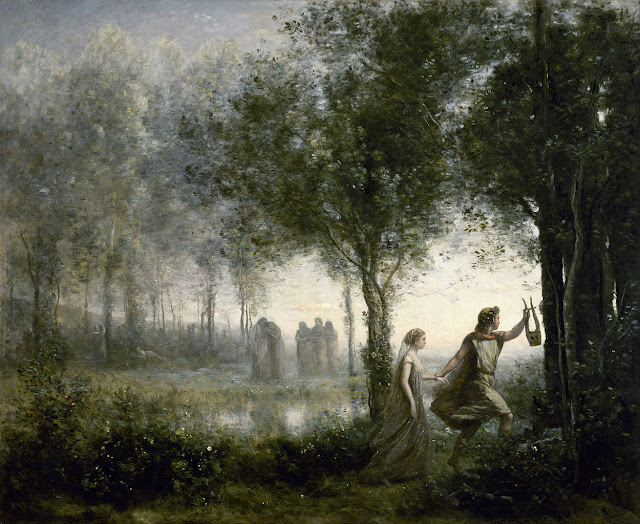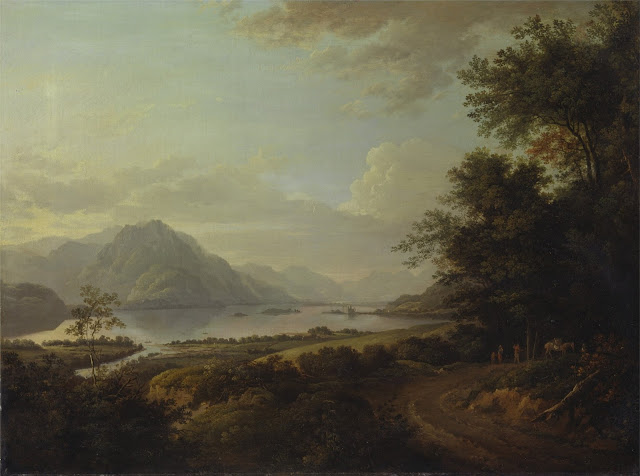The second collection of European and contemporary SocialGalactic art posts is mostly taken up by continental painters. There's a good sample of that tradition here, starting with some old masters of the Baroque era. In painting, the Baroque covers the 17th and early 18th centuries, with different forms in different places. Then the richness of real 19th century art, from the Romantics in the first half of the century to all the diversity that modernism suspended. For more - click for the page linking the art posts or use the button at the top.
Johan Christian Dahl, View of Dresden by Moonlight, 1839
European
We considered breaking the Old Masters into their own category, but there aren't that many and they work well to show the depth of tradition. If Creation is drawing boundaries, making distinctions, and sharpening definitions, modernism is the satanic inversion. The same banal ugliness forever. It isn't just national cultures and traditions that are rejected - historical ones are reimagined as fake milestones on the road to Modernism. This lets us see the Old Masters in their real context. One that points to a viable future for the West.
Romantic painters are known for emotion and energy, but are easiest to understand as reacting against Enlightenment classicism. Wild weather, dramatic light, spectacular scenery, violent human passions are all Romantic features. As a movement it didn't last that long, but the visual effects had huge impact. The Dusseldorf School and the American Hudson River School both draw on Romantic impulses. The rest of the 19th century gives a sense of the variety that modernism rejected. What is ironic is that some darlings of the modern Progress! narrative like Corot look a lot better when put back in their real artistic context. European art is the most impressive and most converged.
Caravaggio, The Calling of Saint Matthew, 1600
Chiaroscuro is high contrast with directed light pulling figures out of darkness. You lose detail, but gain dramatic intensity & 3D presence.
No one did it like Caravaggio.
Caravaggio, The Conversion of Paul, 1601
Distilled to the essence. The light pulls Paul out into our world, showing us the worst can be saved.
The groom doesn’t see yet. But he will.
Adam Elsheimer, The Rest on The Flight into Egypt, 1609
It’s on copper, which raises luminescence. Also non-absorbent so it needs a light touch.
Claude Lorrain, The Embarkation of the Queen of Sheba, 1648
Father of landscape - the first to paint outside in order to study natural light.
Father of landscape - the first to paint outside in order to study natural light.
His settings dominated his canvases & were so popular he became known by first name only.
Jacob van Ruisdael, Wheat Fields, 1670
Dutch old master made a small country’s landscape feel grand.
Dutch old master made a small country’s landscape feel grand.
Low horizon for a spacious feeling & big sky full of monumental clouds gave ordinary scenes an air of importance.
Thomas Wyck, A Scholar in his Study, 17th century
While I know this needs to be resolved as soon as possible and am hoping Hydroxychloroquine is the game changer Trump is suggesting, I’m going to miss social isolation.
[note - Hydroxychloroquine is a game changer. Just need murderous politicians to prioritize public health over elevating body counts for the media]
While I know this needs to be resolved as soon as possible and am hoping Hydroxychloroquine is the game changer Trump is suggesting, I’m going to miss social isolation.
[note - Hydroxychloroquine is a game changer. Just need murderous politicians to prioritize public health over elevating body counts for the media]
Julius von Leypold, Wanderer in the Storm, 1835
That is, a storm.
Carl Friedrich Lessing, Cloister Under the Snow, 1828-1829
The stones & snow make an eye catching contrast, while the monks are just visible going about their devotions.
Carl Spitzweg, Hermit Making Music, 1856
Pleasant picture by a German Romantic. The setting feels like it could come from a fantasy novel.
Pleasant picture by a German Romantic. The setting feels like it could come from a fantasy novel.
The glimpse of sky makes it feel intimate and airy at the same time.
Peder Mørk Mønsted, Sunset over Waterways, 1900
Not photographic, but real in a
way you can feel.
Carl Bloch, Casting Out the Money Changers, 19th century
Bloch’s figures have a timeless classical quality while still seeming real and energetic.
Peder Mørk Mønsted, Spring forest with Sprouting Anemones, 1895
Danish painter with a bright spring vision.
Danish painter with a bright spring vision.
Art is very rhetorical - it stages things for an emotional reaction. Bolster the spirit and sweep out despair.
Caspar David Friedrich, Cross in the Mountains, 1812
Sunday morning picture from the German Romantic pioneer.
Sunday morning picture from the German Romantic pioneer.
Friedrich bound a mystical Christian spirit to the mountains & forests of his native Germany. Stirring &thought-provoking.
Carl Bloch, The Daughter of Jairius, 1881
Sunday picture by a great Danish painter with a timely message in the face of overblown panic.
Sunday picture by a great Danish painter with a timely message in the face of overblown panic.
The staging of the scene is breathtakingly powerful.
Be not afraid, only believe. Mark 5:36
Adelsteen Normann, Sognefjord, 1879
The delicate blues in the sky & water reinforce the appeal of the simple village life. Not an easy life though - no fancies to be found.
Jean-Baptiste Camille Corot, Orpheus Leading Eurydice from the Underworld, 1861
It still ends badly.
Hans Dahl, Summer Day by Balestrand, 19th century
A lot of SJWism comes from modern life supporting disconnect from reality.
Johan Christian Dahl, View of Dresden by Moonlight, 1839
Note the contrast between the silvery moonlight & orange firelight.
Fritz Uhde, Mealtime Prayer (Come, Lord Jesus, be our guest), 1885
Priorities matter in a world filled with fear.
Hans Dahl, Fjord Landscape with a Girl, 19th century
The girl at work & fresh airy view was recurring theme, but he did it so well. You can almost feel the breeze.
Caspar David Friedrich, Wanderer above the Sea of Fog, 1818
The perspective & misty landscape are brilliant, but it’s never been as appropriate as making sense out of the present.
Léon Cogniet, Massacre of the Innocents, 1824
The Bible described it more accurately.
Alexander Nasmyth, Loch Awe, Argyllshire, 1785
Effects like the open space & light background pulling you into depth will become common in the next century.
English
The Romanticism-Classicism pairing isn't quite the same in England, but Turner is as innovative a painter as any Old Master. He paints into the Romantic period using light and paint to add emotional resonance. The Impressionists and other modernists looked to his example. The Band likes his light. The pairing with Grimshaw shows Turner's positive influence in English art. Other scenes show the Victorian taste for heavy-handed emotionalism.
The Romanticism-Classicism pairing isn't quite the same in England, but Turner is as innovative a painter as any Old Master. He paints into the Romantic period using light and paint to add emotional resonance. The Impressionists and other modernists looked to his example. The Band likes his light. The pairing with Grimshaw shows Turner's positive influence in English art. Other scenes show the Victorian taste for heavy-handed emotionalism.
J. M. W. Turner, The Harbor of Dieppe, 1826
Sun & reflection are a bright axis that makes us squint to see a scene that feels both real & far away.
J. M. W. Turner, Venice: The Dogana and San Giorgio Maggiore, 1834
Artists loved Venice for the magical combination of light and water.
John Atkinson Grimshaw, The Lady of Shalott, 1878
When literary painting is done well it transforms how you see the source.
Briton Riviere, A Legend of St. Patrick, 1877
According to legend, when a group of druids gathered to kill his followers, he prayed & they saw only deer.
John Atkinson Grimshaw, On the Clyde, 19th century
Note the detail on the front parapet. It’s what makes a magical scene feel real.
Thomas Faed, The Last of the Clan, 1865
And a timely message in an era of globalist-driven “immigration”. They hate your culture & family.
John Atkinson Grimshaw, A Moonlit Landscape, 1880s
My words fail before his gas & moonlight in the fog & on damp surfaces. Just look closely. He won’t disappoint.
Contemporary
The most eclectic of categories because of the nature of modern art. With the official venues converged and inverted, real artists don't have the same relationship with tradition that they used to. It's way more fragmented. The artist's journey today is more personal - more of the autodidact's path. Compare the first one to the Ruisdael and see how easy it is to revive mastery.
This means variety - in style, subjects, materials - but the old standards still apply. Look for techne and logos and you're on the right track.
Susan Downing-White, Almost an Island, 2010s
Especially the dramatic skies, but combined with the unique feel of that environment.
Arsen Kurbanov, Portrait of a Dagestani Girl, 2015
It’s important to promote contemporary artists that aren’t pozzed. This is a remarkable portrait from a Dagestan-born Russian artist.
It’s important to promote contemporary artists that aren’t pozzed. This is a remarkable portrait from a Dagestan-born Russian artist.
The close-up is even more remarkable.
Aleksandr Averin, Walk #3, around 2017
The works are less polished, but
fresher and more spontaneous.
Daniel Gerhartz, Her Mother’s Harp, 21st century
And a pleasant piece by a contemporary painter reminding us that staying home used to be called “life”.
And a pleasant piece by a contemporary painter reminding us that staying home used to be called “life”.
If “isolating” with yours is a
burden, you’re not doing it right.










































No comments:
Post a Comment